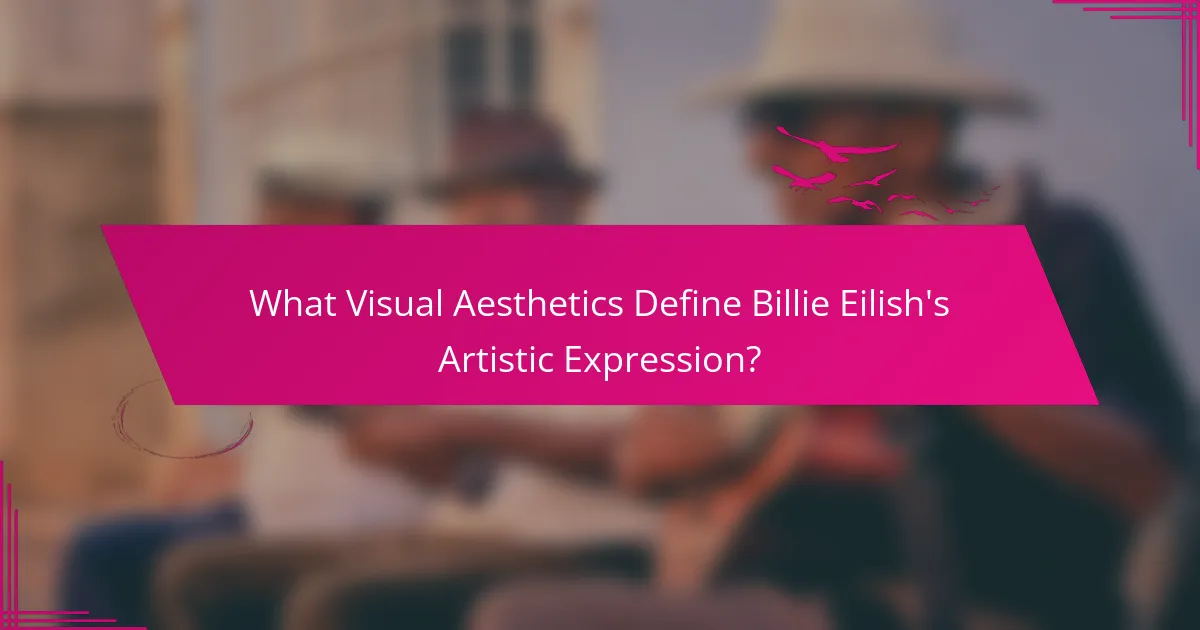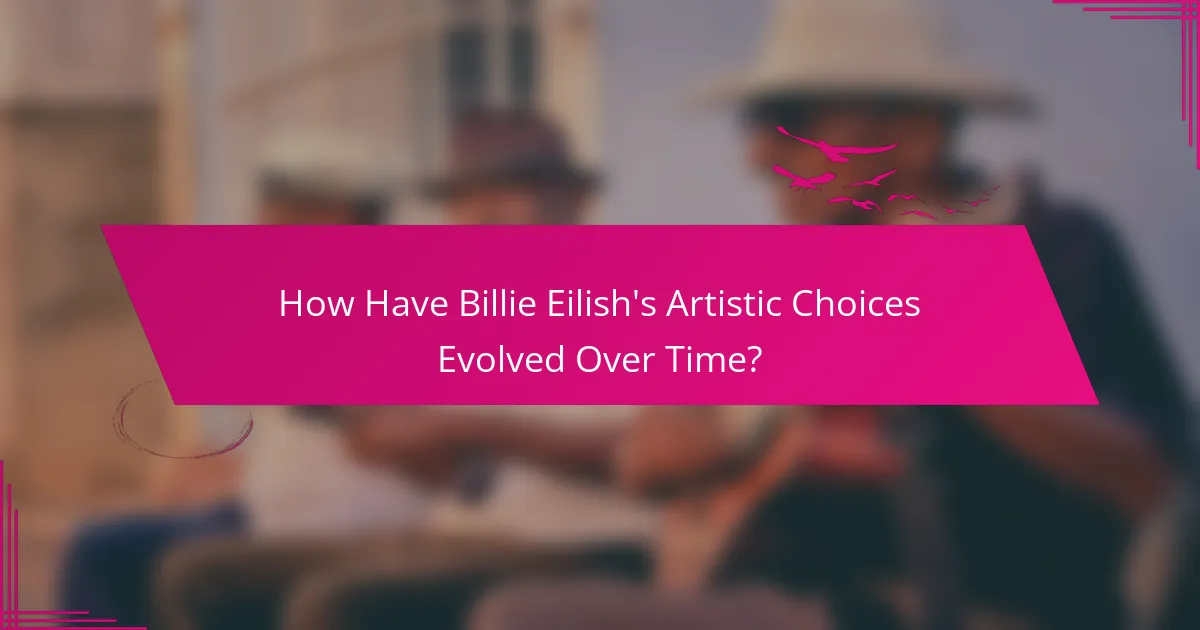Billie Eilish is a prominent artist known for her unique sound and visual aesthetics. Her musical journey began in childhood, gaining widespread recognition with her debut single “Ocean Eyes” in 2015. Eilish’s collaboration with her brother Finneas O’Connell has been crucial in producing chart-topping hits such as “Bad Guy” and “When the Party’s Over.” The article explores her stylistic evolution, highlighting her blend of pop, electronic, and alternative influences, as well as her dark, moody visuals that resonate with themes of mental health and individuality. It also examines her shift from minimalist production to more complex arrangements and her experimentation with bold fashion choices.

What is Billie Eilish’s Artistic Journey?
Billie Eilish’s artistic journey began in her childhood, rooted in a musical family. She gained attention with her debut single “Ocean Eyes” in 2015. This track showcased her ethereal voice and unique sound. Eilish’s collaboration with her brother Finneas O’Connell has been pivotal in her music development. Their partnership has produced multiple chart-topping hits, including “Bad Guy” and “When the Party’s Over.” Eilish’s style merges pop, electronic, and alternative influences. Her visuals often feature dark, moody aesthetics that complement her music. She has received numerous accolades, including multiple Grammy Awards, solidifying her impact on contemporary music.
How did Billie Eilish’s early life influence her music?
Billie Eilish’s early life significantly shaped her music. Growing up in a creative household, she was exposed to various artistic influences. Her parents, both musicians, encouraged her to explore music from a young age. Eilish began writing songs at just 11 years old. This early songwriting experience laid the foundation for her unique style. Additionally, her upbringing in Los Angeles immersed her in a diverse musical culture. Eilish’s personal experiences, including struggles with mental health, informed the themes in her lyrics. These elements combined to create her distinctive sound, blending pop with darker, introspective themes.
What key experiences shaped her artistic vision?
Billie Eilish’s artistic vision was shaped by her upbringing in a musical family. Growing up in Los Angeles, she was exposed to diverse music genres. Her early songwriting started at age 11, influenced by her brother Finneas. Collaborating with him on projects fostered her unique sound. Eilish’s experiences with mental health challenges also informed her lyrical themes. The rise of social media allowed her to connect with fans directly. Performing at intimate venues honed her stage presence. Each of these experiences contributed to the authenticity of her artistry.
How did her family background contribute to her sound?
Billie Eilish’s family background significantly influenced her sound. She was raised in a musical family, which fostered her creativity. Her parents, both musicians, encouraged her artistic expression from an early age. This environment allowed her to experiment with various genres and styles. Additionally, her brother Finneas O’Connell played a crucial role in her music production. He co-writes and produces her songs, shaping her unique sound. Their close collaboration reflects their shared upbringing and musical influences. This familial bond is evident in the emotional depth of her music. Overall, her family background provided the foundation for her distinctive artistic identity.
What are the defining characteristics of Billie Eilish’s music?
Billie Eilish’s music is characterized by its haunting vocals, minimalist production, and introspective lyrics. Her sound often blends pop, electronic, and alternative genres. Eilish frequently employs layered harmonies and subtle vocal effects. The themes in her songs explore mental health, relationships, and self-identity. Her use of silence and space creates a unique atmospheric quality. Collaborating with her brother Finneas O’Connell enhances her distinct sound. The incorporation of unconventional sounds and samples sets her apart from mainstream artists. Eilish’s music videos often feature striking visuals that complement her artistic vision.
What genres and styles influence her unique sound?
Billie Eilish’s unique sound is influenced by various genres and styles. These include pop, alternative, and electronic music. Elements of indie and hip-hop also shape her music. Her collaborations often introduce additional influences. For instance, she incorporates R&B rhythms and trap beats. The production style features minimalism and atmospheric soundscapes. Her songwriting reflects personal experiences and emotional depth. This blend creates a distinct and recognizable sound that resonates with a wide audience.
How does Billie Eilish incorporate lyrical themes into her work?
Billie Eilish incorporates lyrical themes into her work by exploring personal experiences and emotional struggles. Her lyrics often reflect themes of mental health, vulnerability, and self-identity. Eilish uses storytelling to connect with listeners on a deep level. She frequently draws from her own life events, making her music relatable. For example, songs like “Bellyache” discuss guilt and consequence. Her collaboration with her brother Finneas enhances the thematic depth. Together, they create a cohesive sound that complements her lyrical messages. Eilish’s unique perspective allows her to address complex topics in an accessible way. This approach resonates with a wide audience, contributing to her popularity.

What Visual Aesthetics Define Billie Eilish’s Artistic Expression?
Billie Eilish’s artistic expression is defined by a blend of dark, moody visuals and vibrant, contrasting colors. Her music videos often feature surreal imagery that enhances emotional depth. Eilish frequently uses oversized clothing to challenge traditional fashion norms. This choice reflects her desire for comfort and individuality. Her color palette often includes neon greens and blacks, symbolizing her unique identity. Additionally, her visual themes often explore mental health and personal struggles. Eilish’s aesthetic is further complemented by her distinctive hairstyles and makeup styles, which evolve with her music. Overall, her visuals create a cohesive narrative that resonates with her audience.
How does Billie Eilish use visuals to complement her music?
Billie Eilish uses visuals to enhance the emotional impact of her music. Her music videos often feature dark, surreal imagery that reflects the themes of her songs. For example, in “Bad Guy,” the visuals incorporate bold colors and striking contrasts to convey a sense of playfulness and menace. Eilish frequently collaborates with her brother Finneas, who helps create a cohesive aesthetic across her projects. The visuals often include symbolic elements that deepen the listener’s understanding of the lyrics. In performances, her use of lighting and stage design creates an immersive atmosphere. This combination of visuals and sound amplifies the overall experience for the audience. Eilish’s distinct visual style has become an integral part of her artistic identity.
What role do music videos play in her artistic narrative?
Music videos are integral to Billie Eilish’s artistic narrative. They visually represent her music’s themes and emotions. Each video enhances the storytelling aspect of her songs. Eilish employs striking imagery and symbolism to convey deeper meanings. For example, the video for “Bellyache” illustrates guilt and internal conflict through visual metaphors. The aesthetics often reflect her personal experiences and mental health struggles. This connection between visuals and music creates a cohesive artistic identity. Overall, her music videos serve as an essential extension of her artistic expression.
How does her fashion sense reflect her musical identity?
Billie Eilish’s fashion sense reflects her musical identity through bold choices and a distinct aesthetic. Her oversized clothing symbolizes comfort and defiance against traditional beauty standards. Eilish often opts for bright colors and unique patterns, mirroring her eclectic musical style. She frequently collaborates with designers who understand her artistic vision, enhancing her brand identity. Additionally, her fashion choices convey messages about mental health and self-acceptance, aligning with her lyrical themes. Each outfit serves as a visual representation of her individuality and artistic expression. This connection between her style and sound reinforces her authenticity as an artist.
What themes are prevalent in Billie Eilish’s visual aesthetics?
Billie Eilish’s visual aesthetics prominently feature themes of darkness, surrealism, and introspection. Her use of contrasting colors often creates a moody atmosphere. Eilish frequently incorporates elements of the uncanny, enhancing the surreal quality of her visuals. Themes of vulnerability and emotional depth are also prevalent in her imagery. She often uses symbolism to convey complex emotions. The incorporation of avant-garde fashion further emphasizes her unique aesthetic. Eilish’s visuals often reflect her personal experiences and societal issues. This blend of themes contributes to her distinctive artistic identity.
How does she convey emotions through visual storytelling?
Billie Eilish conveys emotions through visual storytelling by using striking imagery and symbolism in her music videos. She employs color palettes that reflect the mood of her songs. For example, darker tones often accompany themes of sadness or introspection. Eilish also utilizes [censured] expressions and body language to express vulnerability and strength. Her use of surreal visuals enhances the emotional depth of her narratives. Additionally, she often incorporates personal experiences into her visuals, creating a relatable connection with her audience. This approach has been effective in resonating with fans, as evidenced by the millions of views her videos receive. Through these methods, Eilish effectively communicates complex emotions visually.
What symbols and motifs frequently appear in her visuals?
Billie Eilish frequently incorporates symbols and motifs such as eyes, water, and nature in her visuals. Eyes often represent perception and vulnerability, reflecting her introspective lyrics. Water symbolizes fluidity and emotional depth, appearing in various music videos to convey themes of struggle and release. Nature motifs, including plants and animals, signify growth and connection to the earth. These elements create a cohesive visual narrative that complements her music. Eilish’s consistent use of these symbols enhances the emotional impact of her artistic expression.

How Have Billie Eilish’s Artistic Choices Evolved Over Time?
Billie Eilish’s artistic choices have evolved significantly since her debut. Initially, her music featured a minimalist production style. This was characterized by soft vocals and subdued instrumentals. As her career progressed, Eilish incorporated more complex arrangements. Her later work includes a mix of electronic and orchestral elements.
Visually, Eilish’s aesthetic has also transformed. Early on, she embraced a casual, oversized fashion style. Recently, she has experimented with bold colors and striking visuals. This shift reflects her growth as an artist. Eilish’s evolution showcases her willingness to explore new creative directions. Her ability to adapt has resonated with a diverse audience.
What milestones mark significant changes in her career?
Billie Eilish’s career milestones include her debut single “Ocean Eyes,” which launched her into the spotlight in 2015. The release of her first EP, “Don’t Smile at Me,” in 2017 marked her first major commercial success. In 2019, she won five Grammy Awards, making her the youngest artist to achieve this feat. The release of her album “When We All Fall Asleep, Where Do We Go?” also marked a significant change, debuting at number one on the Billboard 200 chart. Her collaboration with Finneas on multiple tracks has been pivotal in defining her unique sound. Additionally, her music videos, particularly for “Bad Guy,” have garnered critical acclaim for their innovative visuals. Each of these milestones reflects her evolution as an artist and her impact on contemporary music.
How has her sound evolved from her debut to her latest work?
Billie Eilish’s sound has evolved from her debut to her latest work by incorporating a wider range of musical styles and production techniques. Her debut EP, “Don’t Smile at Me,” featured a minimalist pop sound with dark, introspective lyrics. In contrast, her latest album, “Happier Than Ever,” showcases a blend of pop, rock, and jazz influences. The production has become more complex, with richer instrumentation and vocal arrangements. Eilish has also experimented with different themes, moving from teenage angst to more mature reflections on fame and relationships. This evolution reflects her growth as an artist and her willingness to explore new sonic landscapes.
What influences have shaped her artistic direction in recent years?
Billie Eilish’s artistic direction in recent years has been shaped by personal experiences and societal issues. Her mental health struggles have influenced her songwriting and themes. Eilish often explores topics like anxiety and depression in her music. Collaborations with her brother Finneas O’Connell have also played a significant role in her sound development. They experiment with genre-blending and unconventional production techniques. Additionally, her fascination with visual art and fashion informs her aesthetic choices. Eilish draws inspiration from various artists, including Lana Del Rey and Tyler, The Creator. This eclectic mix of influences contributes to her distinctive style and narrative depth.
What impact has Billie Eilish had on contemporary music and culture?
Billie Eilish has significantly influenced contemporary music and culture. Her unique sound blends pop, electronic, and alternative genres. Eilish’s music often explores themes of mental health and vulnerability. This resonates with a younger audience seeking authenticity. She has challenged traditional pop norms through her unconventional style and visuals. Eilish’s fashion choices promote body positivity and self-acceptance. Her success has inspired many emerging artists to embrace individuality. Eilish has won multiple Grammy Awards, highlighting her impact on the industry.
How has she influenced other artists in the industry?
Billie Eilish has significantly influenced other artists in the industry through her innovative sound and visual aesthetics. Her genre-blending music has inspired a new wave of artists to experiment with pop, electronic, and alternative styles. Eilish’s raw and authentic lyrical content encourages artists to express vulnerability in their work. She has also popularized a minimalist production approach, prompting many to adopt a less-is-more philosophy. Her distinct fashion sense challenges traditional norms, influencing artists to embrace individuality and self-expression. Collaborations with diverse musicians showcase her versatility and have encouraged cross-genre partnerships. Eilish’s success at major awards, including multiple Grammys, sets a benchmark for aspiring artists. Her impact is evident in the growing number of artists who cite her as an inspiration in interviews and social media.
What cultural conversations has her work sparked?
Billie Eilish’s work has sparked conversations around mental health and body image. Her lyrics often address anxiety, depression, and self-acceptance. This has resonated with many young listeners, creating a dialogue about these issues. Eilish’s fashion choices challenge traditional beauty standards. She promotes individuality and self-expression through her unique style. Her music videos often incorporate themes of vulnerability and empowerment. This has led to discussions about authenticity in the music industry. Eilish’s influence extends to conversations about environmentalism and activism. She uses her platform to advocate for climate change awareness and social justice.
What can aspiring artists learn from Billie Eilish’s journey?
Aspiring artists can learn the importance of authenticity from Billie Eilish’s journey. Eilish gained fame by staying true to her unique sound and style. She collaborated closely with her brother, Finneas, which emphasized the value of strong partnerships. Eilish’s willingness to express vulnerability in her music resonates with audiences. She also demonstrates the significance of embracing individuality over mainstream trends. Her innovative approach to visuals showcases the impact of cohesive branding. Eilish’s success illustrates that artists can thrive by breaking conventional norms. Her journey emphasizes that passion and hard work are crucial for achieving artistic goals.
What strategies can they adopt to develop their unique sound?
Artists can adopt several strategies to develop their unique sound. They should experiment with different musical genres and styles. This exploration allows for the blending of influences. Collaborating with diverse musicians can introduce new elements. Utilizing unconventional instruments can create distinctive textures. Engaging in songwriting workshops can refine their lyrical skills. Regularly recording and analyzing their music helps identify unique traits. Embracing personal experiences in their lyrics adds authenticity. Lastly, staying true to their artistic vision fosters originality.
How can they effectively integrate visual aesthetics into their art?
They can effectively integrate visual aesthetics into their art by utilizing color theory, composition, and symbolism. Color theory guides the emotional impact of their visuals. For example, warm colors can evoke feelings of passion, while cool colors may convey calmness. Composition involves the arrangement of elements to create balance and focus. A well-composed piece can draw the viewer’s eye to key areas. Symbolism adds deeper meaning to visuals, allowing for personal interpretation. Billie Eilish often employs these techniques, as seen in her music videos and album covers. Her use of contrasting colors and striking imagery enhances her artistic expression. This approach has garnered critical acclaim and a dedicated fan base.
The main entity of this article is Billie Eilish, a prominent contemporary artist known for her unique sound and visual aesthetics. The article explores Eilish’s artistic journey, highlighting her early life influences, key experiences, and the evolution of her music and visuals. It details her collaboration with her brother Finneas, the defining characteristics of her sound, and the emotional depth of her lyrics. Additionally, the article examines the impact of her fashion choices and the thematic elements present in her visuals, as well as her influence on contemporary music and culture. Insights into her artistic evolution and the lessons aspiring artists can learn from her journey are also discussed.